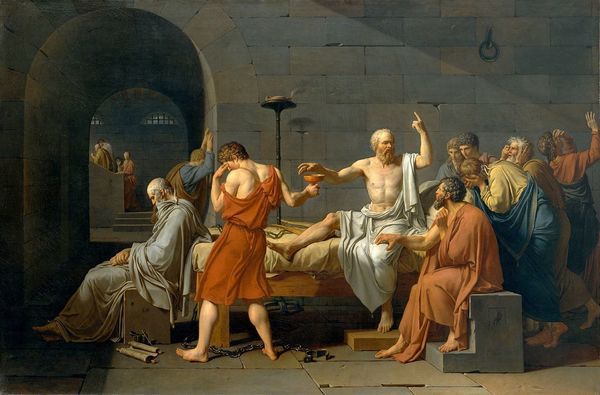by Costica Bradatan

Suppose there is a manner of doing philosophy that, strictly speaking, doesn’t involve writing and speech-making, lecturing and teaching—indeed, a form of philosophizing that doesn’t even need language. Suppose, further, that this form of philosophizing is all about performance, bodily performance. Philosophers have exhausted all their usual approaches and methods, and now have to put their bodies on the line. The situation doesn’t lack irony: a logo-centric discipline finds itself one day in a state where words are useless and arguments futile; no matter how persuasive the philosophers, they will convince no one unless they decide to abandon lecturing and arguing and turn their own flesh into an argument. This is precisely the limit-situation on which I focus in Dying for Ideas: The Dangerous Lives of the Philosophers (Bloomsbury, 2015), and for whose research and writing I used my stay at the NDIAS a couple of years ago.
Socrates was among the first to learn, out of personal experience, what the situation entails. His failure to make his fellow-Athenians see the worth of his philosophical project, as evidenced especially by his trial and death sentence, must have persuaded him not only that there is a limit as to what language can do for philosophy but also that the philosopher, if he is not to betray his vocation and himself, needs to take philosophizing beyond that limit. There is a point, Socrates must have realized as he listened to the death sentence the Athenian jury pronounced against him, where philosophy, if it is not to lose face and end up in failure, has to use something stronger than words to do its job. And what is stronger than words, in such a situation, is the philosopher’s own death. By the means of his dying body—and the public spectacle of his death—Socrates had to communicate whatever he could not through his whole mastery of the Greek language.
His intuition turned out to be right: by dying the way he did, Socrates accomplished something unique. He managed to solidify a meaningful link between his work and his biography. In the absence of a “philosophical death,” not only would have Socrates’s life lacked a defining feature, but his work, too, would have been incomplete. Indeed, without a body of written text, it is hard to imagine how Socrates’s name would have survived in a discipline that, from its inception, has been defined by writing. When it comes to the pre-Socratics, we stick to, and treasure, even the most insignificant fragments from them that we can find. If, for some reason, these fragments would be lost forever, the fear is that the philosophers who left them somehow would be lost as well. When it comes to Socrates, however, we don’t have this problem. We don’t have anything from him, not even the briefest of fragments, but that does not seem to bother us; it is as though his life and especially his death are his work. As long as we have those, we have all we need, and Socrates is in no danger to disappear from history.

Indeed, philosophy thrives when the philosopher chooses to die as a matter of consistence with his beliefs. Socrates’s death was only the beginning of a tremendously influential posterity, which in the absence of any written work is nothing short of miraculous. Hypatia, too, has been a very influential figure, even though nothing has come down to us from her. Giordano Bruno is rarely read today but is thought to be one of the greatest Italian philosophers of all time. What makes these figures “great,” I argue in Dying for Ideas, is the manner of their death. Not only does this particular type of death not annihilate its victims, but it makes them stronger.
These philosophers’ ways of life, their being perceived as “out of place” in society, the dramatic build-up that leads to their singling out, the distinct sense of “crisis” that pervades the communities in the midst of which they emerge, then their violent ending—all of these call for a Girardian reading of the event of their death. From Girard’s perspective they all bear “victimary signs.” Committed as they are to “straight talking” (parrēsía), to leaving nothing unquestioned, and undermining all the little lies and certainties on which social life is based, these philosophers are structurally incapable of establishing ties with others. They remain perpetual outsiders to their own communities. They don’t allow themselves to recognize and cultivate those strong bonds of complicity that keep society together. It is telling that these philosophers’ remarks always come across as “acidic”; no bonds can stand the corroding effect of their parrēsía. In times of crises they become easy targets because their philosophy has made them fundamentally vulnerable.

This may explain why we always tend to misinterpret what these philosophers did or said or who they were while they were alive. We regard Socrates as the “founder” of Western philosophy. Technically he couldn’t be because there were other philosophers before him, but we call them “pre-Socratics.” Hypatia is often seen as having founded the tradition of women in philosophy, even though there certainly were women philosophers before her. She is also associated with the foundation of philosophical feminism (at least two feminist journals bear her name), even if, since her work has not survived, it is difficult to tell exactly what was feminist about it. The death of these philosophers simply “blinds” us. Our reception of them is not strictly rational; it’s tinted by mythology.
Indeed, sometimes mythic or religious language itself is used to frame the biographies of these philosophers. In his ironical way, Erasmus sanctified Socrates: Sancte Socrates, ora pro nobis! A profoundly anticlerical thinker such as Voltaire starts speaking like a man of the cloth when it comes to the Athenian philosopher: “The death of this martyr,” he says, “was actually the apotheosis of philosophy.” Leconte de Lisle decries the murder of Hypatia, a young lady of an extraordinary beauty, gifted with “le souffle de Platon et le corps d’Aphrodite.” That’s a daring act of imagination: at the peak of her career, when she was killed, Hypatia was a sixty-year-old lady. Certainly, these things were not meant literally; they are rhetorical devices. But that’s precisely why they say so much.
The case of the martyr-philosophers points to an important fact, which is one of the broader points I seek to make in my book: the formation of intellectual and philosophical traditions is not governed by strictly rational patterns but sometimes by forms of mythic thinking and imagination. Typically, we tend to think that myth and reason are opposites and that one subverts the other. Yet this may be a simplistic picture. Sometimes myth in fact complements reason. For myth-making and mythic imagination can bring to philosophy a level of depth and sophistication that reason alone cannot secure.
Costica Bradatan
Associate Professor of Honors, Texas Tech University
Fall 2012 NDIAS Fellow